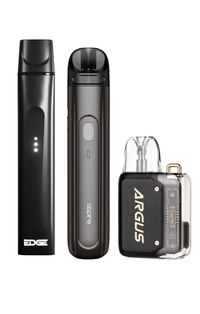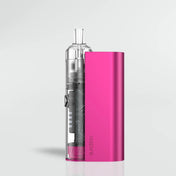How Long Do Vape Batteries Last?
Vape kits come in all shapes and sizes. They also have a wide range of power settings, some of which come pre-set, others give you the option to customise the wattage. Which you choose can largely be determined by the e-liquid you choose, but that is another question altogether.
No mater which you choose, the battery in your vape device will only last so long, and understanding that lifespan can help you plan your vaping journey accordingly – you don’t want to be caught short, leaving you unable to satisfy a craving when out and about.
In this guide, we will explore how vape batteries are rated, what that means in terms of battery life, and the different factors that can extend or reduce that lifespan of your vape's battery.
Understanding Milliampere Hour (mAh) ratings
We don’t want to get too complicated here – electric technicalities can become a of a blur of jargon and we know that most vapers won’t have a degree in electrical engineering.
Most vape batteries you encounter will carry a milliampere hour or mAh rating. For example, the Innokin Endura T18 II vape pen is rated at 1300mAh.
A milliampere hour is, by definition, 1000th of an ampere hour or ‘amp’.
The mAh rating of a battery is an indicator of the charge a battery will hold and how long a device it powers can run before needing to be recharged.
For example, a 900mAh battery should last for around 9 hours before needing to be recharged. This is of course only in ideal conditions and being used in a very standardised way – not truly representative o real life, where temperatures, and personal behaviours alone can have a significant impact on that lifespan.
Capacity Vs Voltage & Amps
A batteries capacity is represented by the mAh rating – the bigger the battery, the bigger that number will be and the more charge it can hold which ultimately means you can use it for longer between charges.
Voltage is the output force of the battery. In vaping, this is directly linked to the coil resistance (which you can learn about here) in your chosen kit. Pro coils for example are 1.2ohm.
To make it easier to understand - Voltage and Wattage are two different ways of describing the same thing. If you increase the voltage, it increases the wattage going to the coil, which creates more heat and ultimately vapour.
The ohm rating of the coil determines how much power it needs to work optimally, but also places a cap on how much it can take. Crank up the wattage too much and you can burn out your coil. So take care!
Variable Wattage Vaping
Many devices come with the ability to customise the wattage. This can allow you to tailor your vaping experience to your needs, but also means you must be careful as you can exceed the safe operating capacity of your chosen vape coil and burn it out. The safe range is often written on the coil, so check before you vape.
The more you crank the wattage, the more volts are being drawn from the battery which means it will drain much faster than if it were kept to a lower level. This is why sub-ohm devices using HVG e-liquid often are larger in size – they need bigger batteries to provide more practical usage time between charges.
Even when given big batteries however, they will rarely last as long as a smaller 50-50 style device like the EDGE GO. They need more watts to properly heat up the high resistance coils they use and vaporise that thicker vape liquid.
Most current devices have built-in chips like the VooPoo Argus P1, that accurately read the resistance of the coil attached to the battery and adjust the power output accordingly. Simple kits tune themselves without giving you any choice, those with variable wattage can be changed form the recommended settings if you so desire.
Internal vs External Batteries in Vapes
Some devices will have integrated vape batteries, whereas others use external cells. There isn’t always much of a difference in performance so long as they have a similar mAh rating, however externals do allow you to swap them out for higher-capacity examples without needing to buy a new kit – potentially doubling the lifespan between charges.
Take care when using external batteries as they can become damaged when taking them in and out for charging. They are wrapped in a protective plastic film. If this becomes damaged it is best to avoid using the battery as it could become unstable. Your vape batteries last longer if they're in a good condition, and it will save you having to buy replacement batteries.
Even with internal batteries, ensuring they are not banged around or exposed to the elements will help keep you safe and protect their performance. Maintaining your vape device to remain in good condition will keep your vape functioning properly, with undamaged batteries!
Common external batteries are called an 18650, this is because they are 18mm in diameter and 65mm in length (expressed as tenths of a millimetre, hence 650). Other sizes are available, but these are the most common should you need to search for an external cell for a device sold to you without any included. Like other vape batteries they come in different ratings from 2200mAh to around 3000mAh.
How Long Does It Take To Charge A Vape Battery?
Different types of vape batteries take different lengths of time to recharge. Different types of vape devices use different battery types which vary in size and the bigger the battery, the longer it will take to charge.
Some devices utilise fast charge features where your device can recharge within 30 minutes, but external batteries will take longer to charge, around 2-3 hours for a full charge.
Size Matters
If you have a small device the battery is going to have a lower capacity. If that device is then used to power a sub-ohm coil, requiring a high watt/volt output, then the battery life will suffer.
Conversely, a larger device battery powering a coil rated above 1.0ohm needing only 10watts to work properly is going to last you a long time, potentially all day if you are a steady rather than heavy vaper.
Depending on your lifestyle, you should bear this principal in mind to ensure you do not end up with a vape kit that is impractical for your needs – such a misstep could derail a cessation journey and trigger a smoking relapse if you are without your vape for a long time!
If you use a smaller device with built-in batteries for travel or just convenience, then it is wise to carry a second battery to cover any emergencies and to use while you charge your device you normally use. And if you use a vape mod that has external larger batteries, carry a spare set in a case with you so you're not caught short.
How Long Does A Vape Kit Battery Last?
Rather than how long it lasts between charges, lets talk about how long a vape battery actually is designed to last for.
How long a battery lasts will vary depending on the many factors at play in determining the lifespan of your vape battery, but batteries in vapes last between 6 months to a year. Of course some may last you longer, but ultimately the battery’s charge cycle will put a cap on performance.
A charge cycle refers to the number of times a battery can expect to be recharged and still perform as intended. For many vape batteries the expectation is 300 charges. If you are charging your vape once per night for example, this should give you around 1 years use before it fails.
Signs your battery is failing include not holding charge as long, not charging up to full at all, or taking longer to recharge than normal. The more regularly you recharge the battery, the shorter it’s lifespan will be. This is why it is good practice to allow any item using batteries, not just vapes, to empty before recharging them – this will prolong their lifespan.
Can You Recharge A Disposable Vape?
One of the commonly asked questions relating to disposable vapes is the one above, and to answer in short, no you cannot recharge a disposable vape.
Whilst acting as a convenient way to vape, they do have many downsides to them with the battery not being rechargeable being one of the main things which can make them a costly way to vape.
The battery in a disposable vape is a relatively small battery, around 350mah, simply because a bigger battery cannot fit into a disposable as they are designed to be small, discreet devices. Normally, the devices have a specific amount of puffs advertised on the packaging, around 600. To put this into retrospective of how long a battery lifespan is in a disposable device, it could be as short as just one day depending how often you use it.
The more the device is used will affect how long the battery will last, and the device will stop working once this battery runs flat or the vape juice inside the device runs out, whichever happens first then signals it's reached the end of its life.
This is where they can prove to be a costly way to vape as you would have to consistently buy replacement devices every day to be able to continue to vape.
It's more beneficial and cost-effective to get a device where you can charge your vape battery, which will be likely to last you all day when the battery is fully charged. And these can be recharged many times before it needs replacing.
Thankfully there are plenty of great alterntives to disposable vapes available including combining EDGE Bar Salt vape liquid with a refillable pod kit like the Vaporesso Xros 3.
How To Maximise Your Vape Battery Life
Follow these basic steps to prolong your battery life and get the most form your vape kit:
- Don’t overcharge your battery, this can affect battery cells.
- Don’t expose your battery to extreme temperatures
- Store external batteries in a sleeve or battery case to avoid damage or discharge.
- If using external batteries, make sure to use a battery charger rather than charging them in your device.
- Take care when using a vape device, don’t let it get knocked around too much
- Minimise charging – try to recharge once per day or less where practical/possible as this will determine how long a battery will last in your device.





